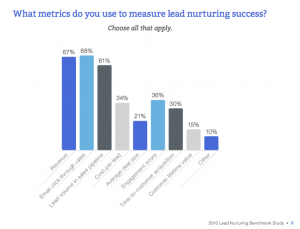
As a B2B technology marketer, you no doubt want the best tools to measure, boost, and grow your marketing efforts. Thankfully, we live in an era of innovative marketing tech. And you can invest in tools for important B2B marketing functions: like content marketing, lead data, website metrics, and more.
27% of CMOs were concerned with staying ahead and taking advantage of digital technology trends, such as the marketing technology stack. – Korn Ferry via SnapApp
Today, digital marketing is complex — and the demands on marketers are growing. But these tools will help you stay ahead in the B2B technology space.
In B2B technology marketing, you need to stay up-to-date with industry trends. But with so many sources to follow, you can find yourself awash in email blasts and information overload.
Thankfully, you can install one of many tools for industry monitoring.
Buzzsumo is one such tool that we use at Ironpaper. This platform identifies which topics in your field are engaging readers and generating social shares. Then, you can quickly find content opportunities around buzzing topics in your tech field.

Furthermore, we recommend bookmarking a free tool like Feedly. You can add various interests related to tech news. Then, you'll automatically follow various publications from one simple dashboard.

As a result, you'll have fodder for technology content topics, and better yet, insight into the pain points of your leads.
Additionally, you'll need to monitor how consumers, prospects, and thought leaders alike are responding to technology trends. A social listening tool will help.
If you invest in a complete marketing platform like HubSpot, you'll have social listening built right in. You can add "streams" to monitor your mentions, watch how your prospects are posting, and skim posts around different topics and tech-related hashtags.

If you're interested in free tools, consider something like HootSuite for monitoring, or SocialMention to see mentions of your brand.
Particularly in the B2B technology space, it's vital to be seen as an industry leader. And many technology marketers realize the need for content that is high-quality, consistent, and authoritative.
57% of B2B marketers struggle to produce content consistently. – MarketingProfs and CMI
Unfortunately, many B2B tech marketers don't have the time to keep up with a demanding content schedule. But there are tools that can help with content curation — a great supplement to publishing.
Therefore, you should add a social curation tool to your stack. For example, Buffer's paid and free versions let you browse the web and "clip" articles of interest to share.

By maintaining a consistent content presence on social accounts, you'll bring in new followers and solidify you company's space as a B2B tech leader. Additionally, you'll increase the chance of your content being referenced.
52% of B2B marketers say that "proving ROI" is a top content marketing challenge.
 (This may be a reason why "lack of budget" is another big concern, reported by 35% of marketers.)
(This may be a reason why "lack of budget" is another big concern, reported by 35% of marketers.)
But in order to prove ROI, you need to dig deeper than "vanity metrics." While many marketers track bounce rate, time on page, and impressions, these metrics won't directly impress a C-suite or win you a budget increase.
Instead, you must measure marketing's relation to business growth. In other words, find a correlation between each marketing action and how it ties back to business objectives. Ask questions such as:
But you can't answer these questions without a lead database tool. Therefore, despite relatively high costs, lead software (sometimes called marketing automation) is definitely worth the investment.
You can begin with HubSpot's Lead In — a free introductory lead monitoring database. Moreover, it plays nicely with WordPress, MailChimp, and other top marketing platforms.
If you need a full-bodied lead database, invest in a platform like HubSpot or Oracle's Eloqua, or Salesforce for an enterprise-level solution.
HubSpot, for example, shows you which channels (social, organic, PPC) are bringing in high-quality leads. Additionally, you can see different reports on how leads consume and convert on your content offers.
 HubSpot's contacts panel for tracking lead data
HubSpot's contacts panel for tracking lead data
These databases will let you implement lead scoring, make lists of leads for marketing segmentation, and gain smart insights to improve lead engagement.
Most importantly, you can track an individual's motion through the sales cycle — and see broader trends about where content is contributing to sales, or could help alleviate bottlenecks in the process.
Ideally, if you're marketing well, you'll have sales leads lining up at your digital door. If this is the case, you'll need a sales CRM to track and manage your deals.
There are a number of free and low-cost solution, revealed by a simple Google search of "free CRM."
However, we recommend a system that integrates with your marketing tool — such as HubSpot's COS and CRM pairing — since alignment between marketing and sales is so crucial.
When sales and marketing teams work together, companies see 36% higher customer retention and 38% higher sales win rates. – HubSpot, The TAS Group
Furthermore, look for a CRM that allows you to set up automated drip campaigns. Since B2B technology cycles are often lengthy and high-touch, it is imperative to keep in touch with leads. And a CRM should let you nurture leads automatically as deal stages pass.
More and more, marketers are moving into a sales enablement role. Now, it's not enough for you to generate leads — you must also help nurture those leads to become customers.
Especially in B2B technology, there are highly technical questions that prospects will want answered. Furthermore, with a high-touch sales process, messaging should be available early on to help move leads down the purchase path.
20% of marketers plan to add messaging apps to their content strategy in the next year. – HubSpot
Although, an informal Ironpaper study revealed that many B2B technology buyers are wary of "distracting" or "creepy" messaging apps. Stick to something that doesn't chime, ding, or otherwise cause a racket for your user. Drift, for example, is a good simple messaging app.
 Screenshot from drift.com
Screenshot from drift.com
If you're putting out content around your technology solutions, you should also be proving its effectiveness.
57% of B2B marketers say that "measuring content effectiveness" is a top challenge. – MarketingProfs and Content Marketing Institute
Whether you use WordPress, HubSpot, or a custom CMS, you should be doing more than just publishing content.
Instead, look for a platform or plugins that allow you to measure content's effectiveness. Particularly in B2B marketing, content should help advance lead generation.
Therefore, you should identify:
Choose a CMS that lets you see the "bigger picture" behind your B2B content efforts.

These functionalities are built in to most marketing automation systems, but you can also invest in a tool like SEOrush to dig deeper with SEO, WordStream for paid ad help, and Wistia for video content analytics.
If you use WordPress, you can bolster your content editor with plug-ins. For example, Yoast is a popular SEO plug-in. And Edit Flow, another personal favorite, helps you plan content on a simple calendar. Additionally, for the truly tech-minded, Advanced Custom Fields let you customize dashboards and data management in WordPress.
So far, we've talked about the value of measuring ROI on your content campaigns, and tracking leads through the lifecycle. But what about greater trends, such as your website's ability to reach and convert different audience segments?
In B2B technology marketing, you often reach several buyer segments, such as technical buyers vs. decision makers.
Therefore, you will need to monitor your ability to reach various segments — and create impact that compels them to convert.
We highly recommend Google's tool suite for all things analytics. You can use Spreadsheets to track and store data over time. Analytics will help you identify different segments and their engagement with your digital presence. And the newer Google Data Studio will help you create and present beautiful visual data reports, for every web metric under the sun.
 Google's Data Studio
Google's Data Studio
You will need to be comfortable with Google Analytics or a similar data platform to use it effectively, but you can take a free Google Analytics certification.
Additionally, you can hire a digital marketing agency well-versed in analytics to measure ROI for you, and create campaigns that boost your business objectives.
Sources
MarketingProfs and Content Marketing Institute. https://www.statista.com/statistics/245138/b2b-content-marketing-challenges-in-north-america/
HubSpot, The TAS Group. https://blog.hubspot.com/sales/stats-that-prove-the-power-of-smarketing-slideshare
Hubspot. https://www.hubspot.com/marketing-statistics
Korn Ferry via SnapApp. https://www.snapapp.com/blog/marketing-technology-stack
by Jonathan Franchell, CEO of Ironpaper - For more tips and hacks: Need to remove a new line after h1 tags? Both web designers and SEO practitioners need to employ headline tags: H1, H2, H3 in several ways to improve web page structure and tag...

The Crowded Arena of the IT Marketplace Updated December 2024 The Information Technology (IT) landscape is experiencing rapid growth and intensifying competition. IT spending is projected to reach nearly 5.1 trillion U.S. dollars in 2024, a...

Updated December, 2024 The field of digital marketing is evolving rapidly in response to new technology and changing buyer expectations. To help career-minded marketers, we’ve rounded up the top 10 skills needed to succeed in the field. These are...

The marketing industry is transforming significantly due to generative AI and increasing market complexity. Gartner's prediction of a 25% decline in traditional search traffic suggests that the era of search engines is dying. AI tools, particularly...
